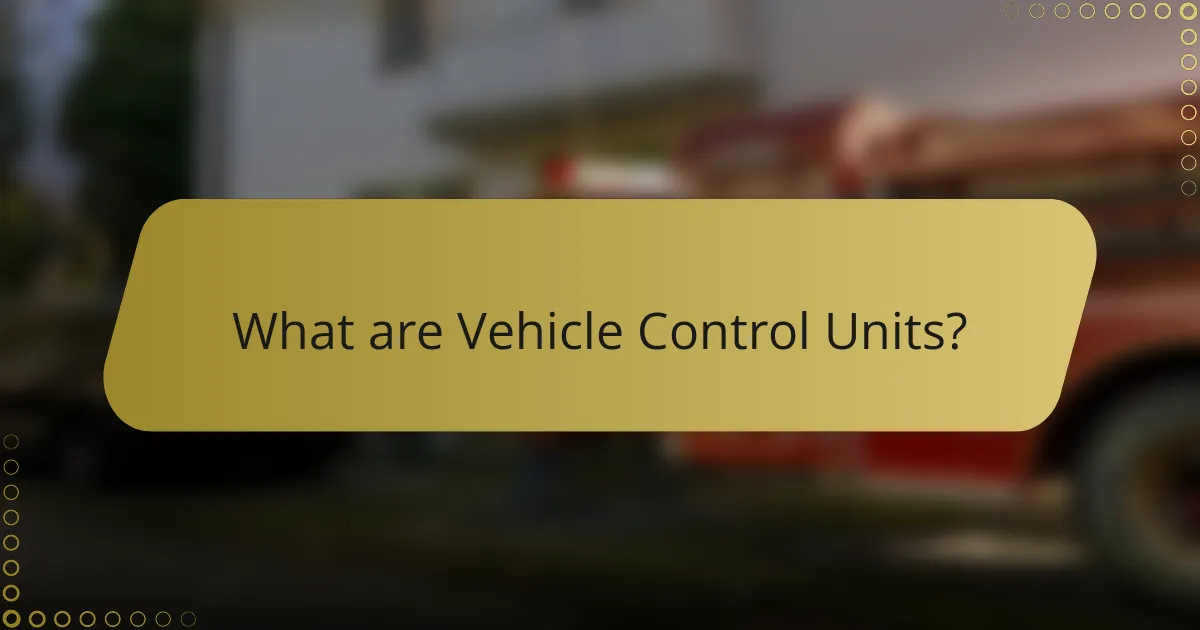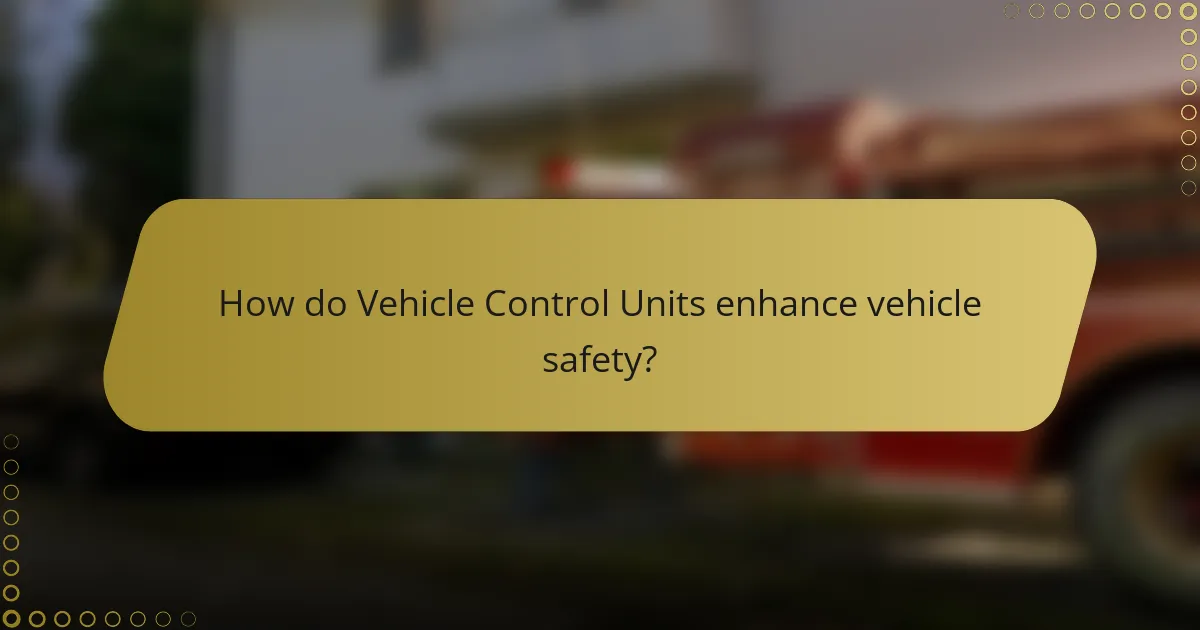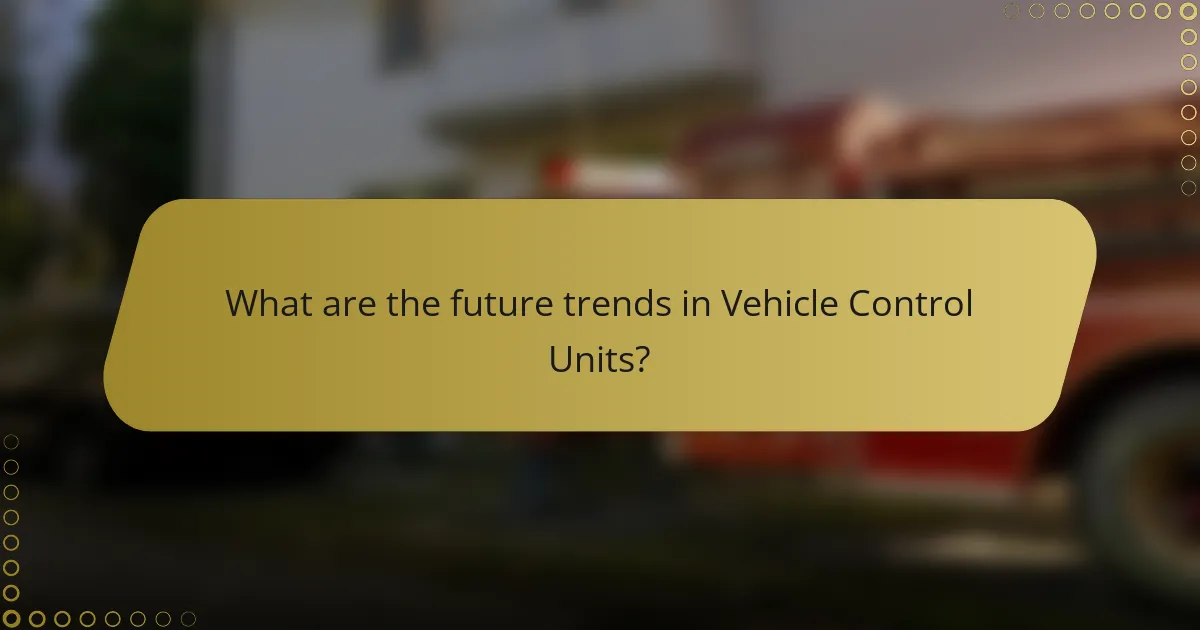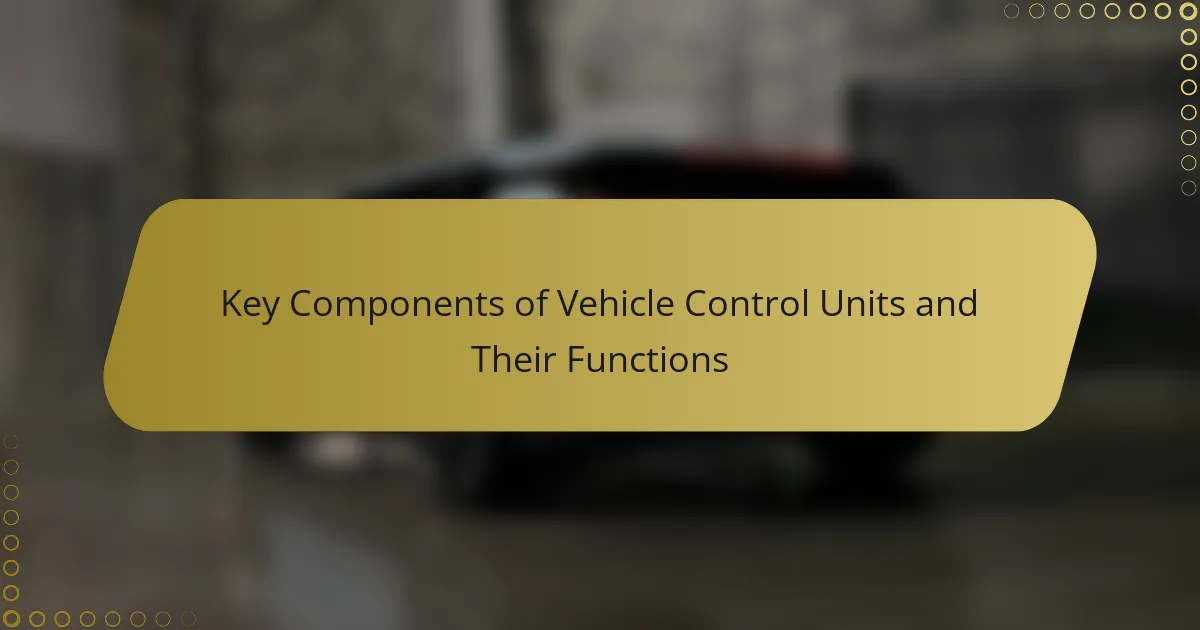Vehicle Control Units (VCUs) are essential electronic devices that manage various vehicle functions, ensuring optimal performance and safety. They process data from sensors and coordinate systems such as engine control, transmission, and safety features, enabling advanced functionalities like adaptive cruise control and electronic stability control. The integration of artificial intelligence and machine learning is shaping the future of VCUs, allowing for improved real-time decision-making and centralized architectures. Additionally, the rise of electric and autonomous vehicles is increasing the demand for sophisticated VCUs that can handle complex sensor data and enhance cybersecurity measures. Trends such as vehicle-to-everything (V2X) communication and sustainability considerations are also influencing the development of VCUs, making them critical components in modern automotive technology.

What are Vehicle Control Units?
Vehicle Control Units (VCUs) are electronic devices that manage various functions within a vehicle. They process data from sensors and execute commands to optimize vehicle performance. VCUs are integral to systems such as engine control, transmission, and safety features. They communicate with other control units in the vehicle to ensure seamless operation. For example, a VCU can adjust engine parameters based on driving conditions. This coordination enhances fuel efficiency and performance. VCUs are essential for modern vehicles, enabling advanced features like adaptive cruise control and stability management. Their role is critical in the development of autonomous driving technologies.
How do Vehicle Control Units function in modern vehicles?
Vehicle Control Units (VCUs) manage various functions in modern vehicles. They receive input from sensors that monitor vehicle performance. These sensors can track parameters like speed, temperature, and pressure. The VCU processes this data and makes real-time decisions. It adjusts engine performance, transmission settings, and safety systems accordingly. For example, it can optimize fuel efficiency based on driving conditions. VCUs also communicate with other electronic control units in the vehicle. This coordination enhances overall vehicle functionality and safety.
What are the key roles of Vehicle Control Units in vehicle operation?
Vehicle Control Units (VCUs) manage critical functions in vehicle operation. They control engine performance, optimizing fuel efficiency and emissions. VCUs also oversee transmission operations, ensuring smooth gear shifts. They monitor vehicle stability, enhancing safety through traction and stability control systems. Additionally, VCUs manage communication between various electronic components, facilitating coordination across systems. They process data from sensors, enabling real-time adjustments for performance and safety. Overall, VCUs are essential for modern vehicle functionality and efficiency.
How do Vehicle Control Units communicate with other systems?
Vehicle Control Units communicate with other systems primarily through standardized communication protocols. These protocols include Controller Area Network (CAN), Local Interconnect Network (LIN), and FlexRay. CAN is widely used for its efficiency in real-time data transmission. LIN is often utilized for less critical tasks due to its simplicity and cost-effectiveness. FlexRay offers higher bandwidth for advanced applications, such as active safety systems.
These communication methods allow Vehicle Control Units to exchange data with various components, including sensors, actuators, and other control units. For instance, the Engine Control Unit (ECU) may send performance data to the transmission control unit to optimize shifting. This interconnected system enhances vehicle performance and safety. The use of these protocols ensures reliable communication and interoperability among different vehicle systems.
What components make up a Vehicle Control Unit?
A Vehicle Control Unit (VCU) consists of several key components. These components include a microcontroller, power supply, sensors, and communication interfaces. The microcontroller processes inputs and controls outputs. The power supply provides the necessary energy for the unit’s operation. Sensors gather data from the vehicle’s environment and systems. Communication interfaces enable data exchange with other vehicle systems. These components work together to ensure the effective functioning of the vehicle’s control systems.
What are the essential hardware components of Vehicle Control Units?
The essential hardware components of Vehicle Control Units (VCUs) include microcontrollers, sensors, actuators, and communication interfaces. Microcontrollers serve as the brain of the VCU, processing data and executing control algorithms. Sensors collect data from the vehicle’s environment, such as speed, temperature, and position. Actuators respond to the commands from the microcontroller, controlling systems like braking and steering. Communication interfaces enable data exchange between the VCU and other vehicle systems or external devices. These components work together to ensure efficient vehicle operation and safety.
How do software components influence Vehicle Control Unit performance?
Software components significantly influence Vehicle Control Unit (VCU) performance. They determine how effectively the VCU processes data from various vehicle sensors. Efficient algorithms enhance real-time decision-making capabilities. This leads to improved vehicle dynamics and safety. Additionally, software updates can optimize existing functions and introduce new features. For instance, adaptive cruise control relies on sophisticated software to maintain safe distances. The integration of advanced driver-assistance systems also depends on robust software architecture. In summary, the quality and design of software components are crucial for maximizing VCU efficiency and functionality.
What are the different types of Vehicle Control Units?
The different types of Vehicle Control Units (VCUs) include Engine Control Units (ECUs), Transmission Control Units (TCUs), and Body Control Modules (BCMs). ECUs manage engine performance and emissions. TCUs regulate transmission functions for optimal gear shifting. BCMs control various body functions like lighting and climate control. Other types include Anti-lock Braking System (ABS) controllers and Airbag Control Units (ACUs). Each VCU type plays a critical role in vehicle operation and safety. The integration of these units enhances vehicle performance and efficiency.
Which Vehicle Control Units are commonly used in passenger vehicles?
Commonly used Vehicle Control Units in passenger vehicles include Engine Control Units (ECUs), Transmission Control Units (TCUs), and Body Control Modules (BCMs). ECUs manage engine performance and emissions. TCUs control the transmission system for optimal shifting. BCMs oversee various body functions like lighting and climate control. Additionally, Anti-lock Braking System (ABS) modules enhance vehicle safety by preventing wheel lock-up during braking. Each unit plays a crucial role in vehicle operation and efficiency. Their integration ensures smooth performance and compliance with safety standards.
What specialized Vehicle Control Units exist for commercial vehicles?
Specialized Vehicle Control Units for commercial vehicles include Engine Control Units (ECUs), Transmission Control Units (TCUs), and Brake Control Units (BCUs). ECUs manage engine performance and emissions, optimizing fuel efficiency and power output. TCUs oversee gear shifting and transmission performance, enhancing drivability and efficiency. BCUs regulate braking systems, ensuring safety and stability during operation. These units often integrate with Advanced Driver Assistance Systems (ADAS) for improved safety features. The use of these specialized units is crucial for compliance with regulations and enhancing vehicle performance.

How do Vehicle Control Units enhance vehicle safety?
Vehicle Control Units (VCUs) enhance vehicle safety by managing and coordinating various safety systems. VCUs monitor data from sensors to detect potential hazards. They control systems like anti-lock braking and electronic stability control. These systems help prevent accidents by maintaining vehicle stability during critical situations. VCUs also facilitate communication between different vehicle systems, ensuring they work together efficiently. This integration allows for quicker responses to emergencies. Studies show that vehicles equipped with advanced VCUs have lower accident rates. For example, a report by the National Highway Traffic Safety Administration indicates that electronic stability control reduces the risk of fatal crashes by 49%.
What safety features are integrated into Vehicle Control Units?
Vehicle Control Units (VCUs) integrate several safety features to enhance vehicle operation. These features include fail-safe mechanisms that ensure continued operation in case of a component failure. Redundancy systems are also present, providing backup operations for critical functions. Additionally, VCUs utilize diagnostic tools to monitor system health and detect anomalies. They implement real-time data processing to respond quickly to potential hazards. Furthermore, secure communication protocols protect against unauthorized access and cyber threats. These safety features collectively contribute to the overall reliability and safety of the vehicle.
How do Vehicle Control Units contribute to collision avoidance systems?
Vehicle Control Units (VCUs) play a crucial role in collision avoidance systems. They process data from various sensors, such as radar and cameras. This data helps the vehicle detect potential obstacles and hazards in real time. VCUs use algorithms to analyze the information and determine the appropriate response. For instance, they can initiate braking or steering adjustments to prevent collisions. The effectiveness of VCUs is supported by advancements in machine learning and sensor technology. These components enable faster decision-making and increased accuracy in threat detection. Studies show that vehicles equipped with advanced VCUs significantly reduce collision rates.
What role do Vehicle Control Units play in airbag deployment?
Vehicle Control Units (VCUs) are crucial for airbag deployment in vehicles. They monitor crash sensors and assess collision severity. Upon detecting a significant impact, the VCU triggers the airbag system. This activation occurs within milliseconds of a collision. The VCU ensures that airbags deploy only when necessary, enhancing passenger safety. It processes data from multiple sensors to make real-time decisions. This precision reduces the risk of accidental deployment. Studies show that effective VCU operation significantly improves airbag performance in crashes.
How do Vehicle Control Units improve fuel efficiency?
Vehicle Control Units (VCUs) improve fuel efficiency by optimizing engine performance and managing fuel injection. They continuously monitor various engine parameters, such as temperature and air-fuel ratio. By adjusting these parameters in real-time, VCUs ensure the engine operates at its most efficient level. For instance, precise fuel injection timing can lead to more complete combustion. This reduces fuel wastage and emissions. Studies indicate that modern VCUs can improve fuel economy by up to 15%. Their ability to adapt to driving conditions further enhances efficiency. VCUs also facilitate better integration with hybrid and electric systems, maximizing energy use.
What technologies do Vehicle Control Units use to optimize fuel consumption?
Vehicle Control Units (VCUs) use several technologies to optimize fuel consumption. These technologies include fuel injection systems, engine control algorithms, and real-time data analysis. Fuel injection systems precisely control the amount of fuel delivered to the engine. This precision enhances combustion efficiency and minimizes waste. Engine control algorithms adjust parameters like air-fuel mixture and ignition timing for optimal performance. Real-time data analysis monitors driving conditions and vehicle performance. This data allows VCUs to adapt strategies for fuel efficiency dynamically. Together, these technologies contribute significantly to reducing fuel consumption in vehicles.
How do Vehicle Control Units adjust engine parameters for efficiency?
Vehicle Control Units (VCUs) adjust engine parameters for efficiency by continuously monitoring and optimizing various operational metrics. They utilize sensors to gather real-time data on engine performance, such as air-fuel mixture, temperature, and throttle position. This data allows the VCU to make precise adjustments to fuel injection timing and duration. Additionally, the VCU can alter ignition timing to enhance combustion efficiency. By managing these parameters, the VCU improves fuel economy and reduces emissions. Studies show that optimized VCU operations can lead to fuel savings of up to 15%. This efficiency is crucial for meeting regulatory standards and enhancing vehicle performance.

What are the future trends in Vehicle Control Units?
Future trends in Vehicle Control Units (VCUs) include increased integration of artificial intelligence and machine learning. These technologies enhance real-time data processing and decision-making capabilities. Another trend is the shift towards centralized architectures. This approach reduces the number of individual control units, streamlining vehicle systems. Additionally, the adoption of over-the-air (OTA) updates is becoming more prevalent. OTA updates allow manufacturers to improve software and features without requiring physical access to the vehicle.
Electric and hybrid vehicles are driving demand for advanced VCUs. These vehicles require sophisticated energy management systems for optimal performance. Furthermore, the rise of autonomous vehicles is pushing VCUs to handle complex sensor data. This includes inputs from cameras, LiDAR, and radar systems. Enhanced cybersecurity measures are also a priority. As vehicles become more connected, protecting against cyber threats is crucial.
The trend towards vehicle-to-everything (V2X) communication is gaining momentum. V2X enables vehicles to communicate with infrastructure and other vehicles, improving safety and traffic management. Finally, sustainability is influencing the design of VCUs. Manufacturers are focusing on energy-efficient components to reduce the overall environmental impact.
How is technology evolving in the realm of Vehicle Control Units?
Technology in Vehicle Control Units (VCUs) is evolving through advancements in software integration and hardware capabilities. Modern VCUs are increasingly utilizing artificial intelligence for real-time decision-making. This evolution enhances vehicle safety and efficiency. The integration of advanced sensors improves data collection and processing. Additionally, vehicle-to-everything (V2X) communication is becoming standard. This allows vehicles to communicate with infrastructure and other vehicles. These developments lead to improved traffic management and reduced accidents. Furthermore, the shift towards electric and autonomous vehicles is driving innovation in VCUs. This includes the need for more sophisticated power management systems. Overall, the evolution of VCUs is crucial for the future of smart transportation systems.
What advancements in artificial intelligence are impacting Vehicle Control Units?
Advancements in artificial intelligence are significantly impacting Vehicle Control Units (VCUs). AI enhances the decision-making capabilities of VCUs by enabling real-time data processing. Machine learning algorithms improve the accuracy of predictive maintenance. Neural networks facilitate better sensor fusion for improved environmental awareness. AI-driven adaptive control systems optimize vehicle performance based on driving conditions. These advancements lead to increased safety and efficiency in vehicle operations. Data from studies shows a reduction in accident rates due to AI integration in VCUs. The automotive industry is increasingly adopting these technologies to stay competitive.
How will connectivity and automation shape the future of Vehicle Control Units?
Connectivity and automation will significantly enhance the functionality of Vehicle Control Units (VCUs). These advancements will enable real-time data exchange between vehicles and external systems. Enhanced connectivity allows for improved vehicle diagnostics and maintenance. Automation will facilitate advanced driver-assistance systems (ADAS) and autonomous driving capabilities. According to a report by McKinsey, the market for connected cars is projected to reach $750 billion by 2030. This growth indicates a strong demand for VCUs that can process complex data inputs. The integration of 5G technology will further accelerate this evolution. With faster data transmission, VCUs will respond more effectively to changing driving conditions. Overall, connectivity and automation are set to redefine the performance and capabilities of Vehicle Control Units.
What are best practices for maintaining Vehicle Control Units?
Regularly updating software is a best practice for maintaining Vehicle Control Units (VCUs). Software updates ensure that the VCU operates with the latest performance enhancements and security patches. Routine diagnostics should be performed to identify any potential issues early. This helps prevent failures and extends the lifespan of the unit.
Additionally, keeping the VCU clean and free from dust or debris is essential. Contaminants can interfere with electrical connections and overall functionality. Ensuring proper electrical connections is also critical. Loose or corroded connections can lead to malfunctions or erratic behavior.
Monitoring the operating temperature of the VCU is another important practice. Overheating can cause significant damage to the unit. Lastly, consulting the manufacturer’s guidelines for maintenance schedules and procedures is vital. Following these guidelines helps maintain optimal performance and reliability.
How can regular diagnostics improve the longevity of Vehicle Control Units?
Regular diagnostics can significantly improve the longevity of Vehicle Control Units (VCUs). By identifying issues early, diagnostics prevent minor faults from escalating into major failures. Regular checks ensure that software updates and recalibrations are applied, optimizing performance. Monitoring system health helps in detecting abnormal behaviors that may indicate wear or malfunction. This proactive approach reduces the risk of unexpected breakdowns, leading to fewer repairs and lower costs. Studies show that routine maintenance can extend the lifespan of electronic components by up to 30%. Thus, regular diagnostics are essential for maintaining the integrity and functionality of VCUs.
What common issues should be monitored in Vehicle Control Units?
Common issues to monitor in Vehicle Control Units (VCUs) include software malfunctions, sensor failures, and communication errors. Software malfunctions can lead to incorrect vehicle behavior or system crashes. Sensor failures may result in inaccurate data readings, affecting performance and safety. Communication errors can disrupt the interaction between the VCU and other vehicle systems. Additionally, power supply issues can cause operational failures. Monitoring these aspects ensures the reliability and safety of the vehicle. Regular diagnostics and updates can help mitigate these common issues effectively.
Vehicle Control Units (VCUs) are essential electronic devices that manage various functions within modern vehicles, optimizing performance and enhancing safety. This article outlines the key components of VCUs, including microcontrollers, sensors, and communication interfaces, and their roles in managing engine performance, transmission operations, and safety systems. It also discusses how VCUs communicate with other vehicle systems through standardized protocols, the integration of advanced technologies like artificial intelligence, and the importance of regular diagnostics for maintaining their functionality. Furthermore, the article highlights future trends in VCUs, including the shift towards centralized architectures and the impact of connectivity and automation on vehicle capabilities.
